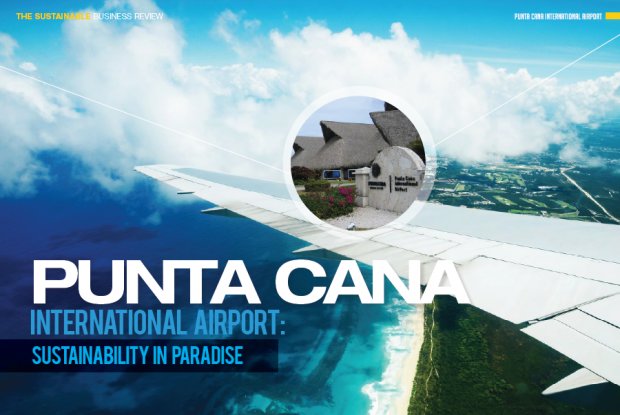Punta Cana International Airport: Sustainability in Paradise

When Dominican businessman Frank Rainieri and his US partner Theodore W. Kheel set out to find a suitable destination for a resort in the early 1970s, they settled on a beautiful stretch of coastline on the west coast of the Dominican Republic called Punta Borrachón, which translated as drunkard’s point. They chose to adopt a new name, Punta Cana, and an international brand in sustainable tourism was born.
From those humble beginnings, Punta Cana’s reputation has rapidly grown, leading to numerous advancement catering to the millions of tourists who visit each year. The destination quickly developed a full service marina and in the early 1980s, opened a modern airport facility that incorporates the most up-to-date eco-friendly design: Punta Cana International Airport. We recently spoke with Hernando Nunez of Punta Cana about the airport, a world leader in sustainable aviation.
From humble beginnings
Cana had little more than a rudimentary road leading to its coastline. As the Director Operation Landside, Mr. Rafael Alberto Smith explains, “The government had no intention of developing tourism in this part of the island. All of its efforts were focused on other areas of the country, and they had to be convinced of Punta Cana’s potential.”
The Punta Cana that now exists is both a tribute to the vision of its founders and the willingness of the government of that time to listen. The MasterCard Global Destination index in 2015 showed that close to 6 million passengers arrived that year from all over the world, representing two thirds of all passengers arriving to the country, ranking it among the 10 most important airports in Latin America and the Caribbean.
Mr. Smith tells us, “After 12 separate expansions since its inauguration in 1983, Punta Cana International Airport now has two terminals for international commercial flights across 75,000 square meters, with the capacity to receive 2,500 passengers every hour, 16 ramps positions, 26 departure gates, 2 airstrips to receive all kinds of airplanes including Boeing 747-400’s, an FBO terminal for private aviation, a duty free area and a food court in each terminal.”
It’s hardly surprising given these statistics that so many airlines have decided to make Punta Cana a valued destination in their service offering. At the last count, nearly 60 airlines in the world, from Europe, the US, Latin America and Asia travel to Punta Cana on regular schedules, making it the most visited destination in the Caribbean and connecting locals to more than 96 cities across the world.
More than the sum of its parts
It is remarkable to think how conscious of sustainability the founders of Punta Cana International Airport were when the airport launched in 1983. At a time, when little thought was given to such matters, at Punta Cana, they were foremost in the plans. Mr. Smith tells us, “the original building imitated native Taino and Arawak structures, using inexpensive local materials such as palma cana thatch for the roof and coral stone for the walls.”
He continues: “the Dominican architect Oscar Imbert positioned the building to allow the coastal breezes to pass through the terminal, thus avoiding the use of air conditioning. The high and open ceiling allows the building to take advantage of natural light and reduce the need for artificial lighting during the day. Today, we operate an efficient waste management program that recycles 60% of the waste produced by airplanes and the airport terminals. The goal is to become a zero waste airport.” In 2014 alone, 1,206 tons of materials were recycled and produced 9.676 gallons of vegetable oil. At this rate, it seems it won’t be long before it achieves its goal of zero waste.
Focusing on people
As we have come to see, Punta Cana International Airport is international in the truest sense, but it has managed to maintain the warmth and human touch that people associate with the Caribbean region as a whole. It is a reputation the Airport is eager to maintain. Mr. Alberto Smith tells us, “Ours is a family friendly airport; each terminal has a kid’s area at the departure gates and each week the airport staffs organize different entertainment options for passengers, especially kids and families, while waiting at the gate for departure.” This dedication to people is validated by the Airport Service Quality Award, issued by the International Council of Airports, which Punta Cana International Airport has won for the past two years.
Its devotion to people doesn’t stop at the airport’s gates; it extends into the local community. Mr. Smith tells us, “Corporate Social Responsibility plays an important role in the owners’ vision – a percentage of profits from the airport are invested in community projects and the company’s mission to promote sustainable development ranges from interest-free educational loans and medical facilities to revolving loan funding for employee housing and an ecological foundation to protect and preserve the land and marine life.”
Partners
Growing that beautiful but wild part of the Dominican Republic where few people had the vision for something bigger demanded Mr. Rainieri and Mr. Kheel recruit a strong team, and over time, an equally strong network of partners and suppliers. Today, among the most important of these are GB Energy Aviation, which supplies aviation fuel and its related facilities not just to Punta Cana, but to airports all over the Caribbean.
Likewise for companies like Caribe Cargo, which supplies world class sales agent and cargo handling services, and the Caribbean Catering Services Company, which manages Punta Cana’s two food courts and feeds six million passengers every year. Elsewhere, the airport is indebted to United Airlines and Aero República, with whom the airport works closely to ensure that visitors receive world class service from the moment they leave the foreign airport to when their trip to the Dominican Republic finishes.
Continued progress in paradise
Employees at Punta Cana have taken to calling it paradise, and there’s something to that. In nearly 50 years, the island has gone from being a forgotten backwater of a beautiful country to one of Latin America’s premier tourist destinations. More admirable still, is that this has all been done with a nod to sustainability - and not just in the last few years, when sustainability has come to the forefront of public thinking, but since the very outset.
Things keep moving at Punta Cana International Airport. Mr. Smith tells us, “Due to the increase in passenger arrivals, the expansion process of terminal B began with 50 new points for check in, 5 new ramp positions, an expanded baggage claim area and a new pedestrian bridge that will connect terminals A and B.” Thanks to progress at Punta Cana International Airport, more people than ever will have access to paradise.
Original souce: http://bit.ly/2osTF0n


